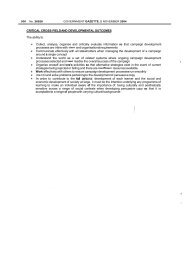The trafficking of children for purposes of sexual exploitation
The trafficking of children for purposes of sexual exploitation
The trafficking of children for purposes of sexual exploitation
Create successful ePaper yourself
Turn your PDF publications into a flip-book with our unique Google optimized e-Paper software.
3.2. Lack <strong>of</strong> effective safety and protection services <strong>for</strong> <strong>children</strong><br />
Child protection services in South Africa have always been severely under resourced. Overstretched<br />
government and NGO structures are expected to respond to this problem, however the increase in<br />
cases has not resulted in a corresponding increase in service provision to the extent that welfare<br />
agencies can adequately cope with the demand placed on their human and financial resources.<br />
Typically child protection organisations, as part <strong>of</strong> the historically marginalised social service<br />
sector, lack basic resources and programme components, which are required to deal effectively with<br />
child abuse.<br />
From the late 1980s onward there was an upsurge in public concern about child <strong>sexual</strong> abuse. This<br />
resulted in a situation where welfare organisations were flooded with new referrals, which they<br />
were ill equipped to respond to. This has heightened the dangers, already rife within the child<br />
protection system, <strong>of</strong> ineffective interventions and <strong>of</strong> secondary abuse <strong>of</strong> traumatised <strong>children</strong>. 59<br />
3.3. Sexual abuse <strong>of</strong> <strong>children</strong><br />
<strong>The</strong> <strong>sexual</strong> abuse <strong>of</strong> <strong>children</strong> by family members and others, such as teachers has been identified as<br />
a contributing factor by interviewees. 60<br />
A participant in the NASEC Conference expressed the causal relationship between child <strong>sexual</strong><br />
abuse and child prostitution thus:<br />
"By <strong>sexual</strong>ly abusing our <strong>children</strong> we are creating a generation <strong>of</strong> prostitutes. Whenever a person <strong>sexual</strong>ly abuses a<br />
child, he will either give her candy, food or money. This causes the child to put value to her body. When she becomes a<br />
runaway, and/or gets hungry, she will turn to prostitution." 61<br />
<strong>The</strong> <strong>sexual</strong> abuse <strong>of</strong> <strong>children</strong> by parents might be an indicator that parents regard <strong>children</strong> as<br />
<strong>sexual</strong>ly mature and there<strong>for</strong>e the effects <strong>of</strong> exchanging money <strong>for</strong> the <strong>children</strong>'s <strong>sexual</strong> <strong>exploitation</strong><br />
might not be regarded as harmful by parents.<br />
Other <strong>for</strong>ms <strong>of</strong> violence and physical abuse <strong>of</strong>ten accompany the high incidence <strong>of</strong> child <strong>sexual</strong><br />
abuse by family members and others.<br />
According to one report the Child Protection Unit provides alarming evidence that a significant<br />
percentage <strong>of</strong> violence committed against <strong>children</strong> consist <strong>of</strong> <strong>sexual</strong> abuse. Between January and<br />
May 1996, 8 038 cases <strong>of</strong> <strong>sexual</strong> abuse <strong>of</strong> girls were reported to the police, <strong>of</strong> which 5 390 were<br />
recorded as rape. 62 This paper also notes that "while boys are more likely to suffer physical assault,<br />
girls are more likely to be <strong>sexual</strong>ly abused, with street <strong>children</strong> being the most vulnerable to rape<br />
and prostitution." 63<br />
3.4. High levels <strong>of</strong> domestic violence<br />
South Africa has high levels <strong>of</strong> domestic violence. <strong>The</strong> SAPS reports that a National Victim Survey<br />
conducted in 1998 found that most assaults (54 percent) and <strong>sexual</strong> assaults (68 percent) occur in<br />
and around the home <strong>of</strong> the victim. 64 This indicates that <strong>children</strong> are subjected to high levels <strong>of</strong><br />
violence. <strong>The</strong> effects <strong>of</strong> this violence on <strong>children</strong> are <strong>of</strong>ten the precipitating factor that causes<br />
<strong>children</strong> to leave home.<br />
<strong>of</strong> 1997.<br />
59 Interviews with representatives <strong>of</strong> organisations<br />
60 Interviews with Annette Cockburn <strong>of</strong> the Homestead, Glynis van Halter <strong>of</strong> Zizane, representatives <strong>of</strong> <strong>The</strong> House and<br />
see also S. Farrell Ibid and Schurink et al Ibid<br />
61 T. Msezana: Ibid p. 60<br />
62 L. Jackson: 'Recent Initiatives in Addressing Gender Violence in South Africa' Occasional Paper No 14 January 1997,<br />
Institute <strong>for</strong> Security Studies p. 12<br />
63 Ibid p.12<br />
64 'Domestic Violence: <strong>The</strong> New Approach' www.saps.org<br />
28
















